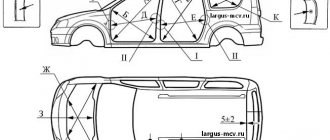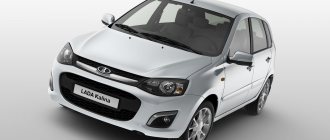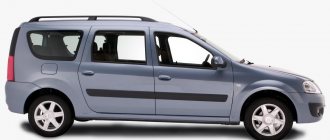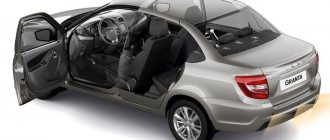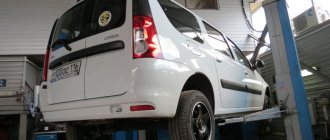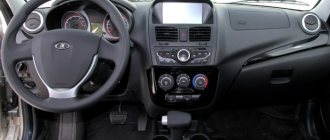03 August 2020 Lada.Online 6 112 0
LADA Largus is a station wagon and high-capacity van based on the Renault-Nissan B0 Alliance platform, the prototype is Renault Logan MCV. There were also design and technological innovations. AVTOVAZ specialists changed not only the style of the exterior and interior of the car, there were improvements in the design of the car.
Body
Body engineering is carried out at the world level. Torsional rigidity is high: the body frame without glued glass has a rigidity of 14,000 N*m/degree (with glass the rigidity is approximately 30% higher). This is a very good indicator: according to test results (torsional load of the body with a certain force), the change in diagonal in the tailgate opening was only 1.5 mm, while on some foreign and domestic analogues this figure reaches 5-6 mm.
The body design allows you to comply with current European requirements for passive safety. One of the important elements of passive safety is the front subframe. It acts as an additional spar that absorbs and redistributes impact energy.
LADA Largus Cross has a design typical of crossovers. The high stance of the car is emphasized by protective plastic linings on the front and rear bumpers, wheel arches and sills, and unpainted bumpers.
Sales statistics with a slight decline
Domestic Lada is better than others in overcoming the crisis associated with the pandemic. If the Russian automobile market as a whole sank by 9.1 percent, then our manufacturer lost only 5%, finding 343,512 buyers. Vesta (107,281 units) and Granta (126,112 units) suffered the least, with a drop of 4 and 7 percent, respectively. In anticipation of the facelift, Largus's performance does not look so rosy. The model attracted 37,166 owners with negative dynamics of 14%. Things are even worse for the X-Ray crossover, which sold 19,286 copies and lost a third of its sales statistics. The new Niva’s performance for the year is not entirely correct, since the SUV returned to its former name in place of Chevrolet only this summer.
Suspension and steering
As you know, the suspension is a component of the car platform. Since LADA Largus is built on the B0 platform, the suspension architecture is similar to other cars on this platform. But due to the fact that the station wagon and van have a relatively large mass, some suspension parts are reinforced. Accordingly, both springs and shock absorbers have original characteristics.
As for the differences from the suspension of other front-wheel drive LADA cars, the LADA Largus design uses a front subframe. The presence of a subframe allows the use of a wishbone suspension - this design makes the suspension more rigid, which allows you to maintain the kinematics laid down by the engineers and has a positive effect on stability and controllability.
Another design feature is that the steering rack is located at the bottom and is mounted on a subframe. The design of the cross member of the instrument panel and the steering rack itself determines the use of a hydraulic booster.
A design feature of the LADA Largus rear suspension is the use of a separate spring and shock absorber design. This design allows you to expand the distance between the rear wheel arches and increase the volume of the luggage compartment - and this is important for a station wagon and a van.
The Lada Largus Cross uses different suspension settings (shock absorbers).
It's in the details
The new configuration of the 5-seater station wagon managed to intrigue. The basis here is the Cross all-terrain version, which is the most crossover-like of the entire Largus family. “High materials” (ground clearance and body height - 195 and 1682 mm, respectively), coupled with black roof rails, are complemented by status innovations - laser-cut alloy wheels and 16-inch Continental tires, black glossy exterior mirror housings and a scattering of Quest nameplates, no matter how cool, setting the intrigue. In short, the impression is that the new version is a touchstone before the upcoming large-scale restyling of the model. It is expected that the updated Largus will be presented at the very beginning of 2022, and it is no secret that the cars will try on the front end in the corporate X-style and will receive layout solutions from the Vesta family and Renault models.
The interior of the “quest” Largus Cross is also a kind of prelude to a large-scale modernization of the model. The main effect of novelty is created by the front seats with combined upholstery (fabric and eco-leather), borrowed from the XRAY Cross crossover. Sitting has become expectedly more comfortable - more powerful lateral support, wider and longer cushion, more convenient settings (including height). Another gift is three-stage heating of the seats. It’s a pity, of course, that the unit is located in a hard-to-reach area - in a niche under the center console. But before, the driver and front passenger had to feel for the buttons, crawling with their fingers along the end of the pillows, and the heating was only single-zone: turned on and off.
The ergonomics of the driver's area of the already “middle-aged” model (its history dates back to 2006) is not optimal by today’s standards, despite regular “cosmetic repairs” of the interior. What is most missing is the adjustment of the steering wheel for reach (there is only one for inclination), the horn signal in the steering wheel hub (the horn button at the end of the left steering column switch is a legacy from the “grandfather” of the Dacia Logan MCV) and the power window buttons on the door panels. On the other hand, Largus Cross impresses with its laconic layout and ease of interior maintenance. For example, the rough plastic trim is easy to clean, just like in commercial vans.
The second row was left unchanged - heating, as before, was not provided; the additional two “gallery” seats remained in the list of options. The spare tire is also mounted under the rear overhang. The rear doors are hinged, with large windows, so this is not a five-door, but a six-door car. As for the trunk, we welcome the bold flight of layout ideas! We are talking about a deep rubberized tray with “toothy” slits in the walls. The photographer and I looked at this new optional attribute, and then it dawned on us: after all, that same mysterious meter-long bar came from this pen! And so it turned out. By rearranging the block in the grooves of the tray, we vary the space. Using the same “meter” we press bags from the supermarket or, say, cans of water, and they do not dangle around the compartment. This is how we solved the “luggage quest” from Largus Quest.
Engine
At first, LADA Largus cars were equipped with two types of Renault power units - a 16-valve 1.6 liter engine with a power of 77 kW (105 hp) with a 5-speed manual gearbox (MT) and an 8-valve 1.6 liter engine with a power of 64 kW (90 hp) coupled with a 5-speed manual transmission.
In 2016, the 8-valve Renault-Nissan K7M engine was replaced by a similar Russian VAZ 11189. And at the end of 2022, instead of the Renault K4M engine, they began to install the VAZ-21129 engine, which is also used on the Lada XRAY and Vesta models.
These engines are characterized by high elasticity, and the manual transmission has excellent gear shift precision. The parameters of the power unit are quite sufficient for confident driving and dynamic acceleration of a relatively heavy car.
Ignition switch illumination
Illumination of the ignition switch is a rather convenient “feature” when the car is frequently used at night in poorly or unlit places.
To modify the ignition switch and install the backlight, a minimum of parts are required, and all the work, including the connection, takes about an hour.
After some simple manipulations with the ignition switch, you will not experience any difficulties when using the car in the dark.
To work you need:
- LED of small diameter, for example, 2.5–3 mm;
- resistance 1–1.5 kOhm;
- the wire.
To install the backlight, you need to remove the lock cover. It is removed together with the immobilizer antenna, and then remove the top cover of the casing.
At the second stage, the LED is installed inside the lock housing. To ensure uniform illumination, small slits can be made in the housing, after which the casing is assembled and installed in place. The wires coming from the LED are pulled to the CEBCS unit and connected to the white connector. To connect the wires, you can use gray or white wires - this is a “minus”. For “plus”, either of the two red wires is used.
Connecting to the CEBKS unit allows you to get the lighting to work similar to turning on the interior lamp - it lights up when the Lada Largus is disarmed, when the doors are opened, and goes out either after the doors are closed or after the ignition is turned on.
Acoustic comfort
Achieving good acoustic comfort is greatly influenced by body rigidity. Being quite rigid, it does not “twist” on bumps, so there is no change in the interfaces between body and interior parts and, therefore, there are no squeaks.
In addition, the interior components are designed so that they do not mate with the body in areas where squeaking would normally occur. This is achieved by ensuring sufficient gaps between the plastic parts of the interior and the body itself, as well as by mounting the plastic parts on special fasteners.
The third component of the acoustic comfort of LADA Largus is carefully selected materials that ensure the absence of squeaking in principle.
Life tests have shown that even with a significant mileage there is practically no extraneous noise.
In mid-2022, AVTOVAZ introduced a special edition of the Lada Largus Cross Quest. This version of the station wagon has improved sound insulation. Several dozen special magnetic and self-adhesive vibration-damping pads appeared on the body floor, on the ceiling, on the front panel, on the doors, and on the rear wheel arches. This significantly reduces vibration and noise and increases comfort when driving in the car.
Self-expanding plugs have appeared in the hidden hollow sections of the body to prevent sound from spreading throughout the body, which is very important for a car with a long wheelbase.
A special microfiber noise-absorbing material has appeared under the interior door trims and on the body pillars. The interweaving of thin fibers provides good acoustic qualities and at the same time improves the thermal insulation of the body. In winter, the Largus Quest interior is warmer, and in summer, when the air conditioning is on, it is cooler.
The expert assessment of the new sound insulation sounds like a “significant improvement.” During intense acceleration, noise in the cabin is reduced by 5 dB; at a constant speed of 100 km/h, the noise is reduced by up to 3 dB. Speech intelligibility in motion (articulation index) improves by 5% (it’s like changing from Priora to Vesta).
Shock absorbers Lada Largus Cross
Cross economics
It is unlikely that there will be conditions in which the geometric cross-country ability of vehicles will play a decisive role. Still, the difference in ground clearance is not so significant. More important, I think, are fuel consumption indicators. The “elevated” Largus spends 1.4 liters more for every hundred kilometers driven in the city and 0.8 liters more when driving on the highway compared to a station wagon without the Cross prefix. At least that's what the manufacturer says. But this is already a noticeable difference, especially over a long distance. What is it due to? Considering that the gear ratios of the cross-modification gearbox have not changed, we can only rely on aerodynamics, wheel size and an additional 35 kg of curb weight.
Tests
LADA Largus cars have been tested in real Russian conditions. During intensive testing, strict AVTOVAZ methods were used: mileage tests in various climatic zones, races at maximum speed, trips on a special cobblestone track, laboratory, road, and impact tests. The main conclusion is confirmation of the high reliability of the car.
Crash tests have shown: LADA Largus fully complies with current European requirements for passive safety.
According to the results of road tests, the car demonstrated excellent handling, stability and a fairly high level of cross-country ability. Large ground clearance, short front and rear overhangs and suspension geometry make it possible to easily and without damage overcome speed bumps, snow drifts, move in ruts, and maneuver in multi-level garages with ramps with a large fracture.
Currently, AVTOVAZ is preparing a restyling of the Lada Largus. An experimental batch of these cars has already been seen on the streets of Tolyatti. Serial production can begin after a corporate holiday, i.e. after August 16, 2022.
Keywords: Lada Largus Cross | front suspension of Lada Largus | rear suspension of Lada Largus | Lada Largus engine | sound insulation of Lada Largus | steering mechanism Lada Largus
0 0 1 0 0 0
Share on social networks:
